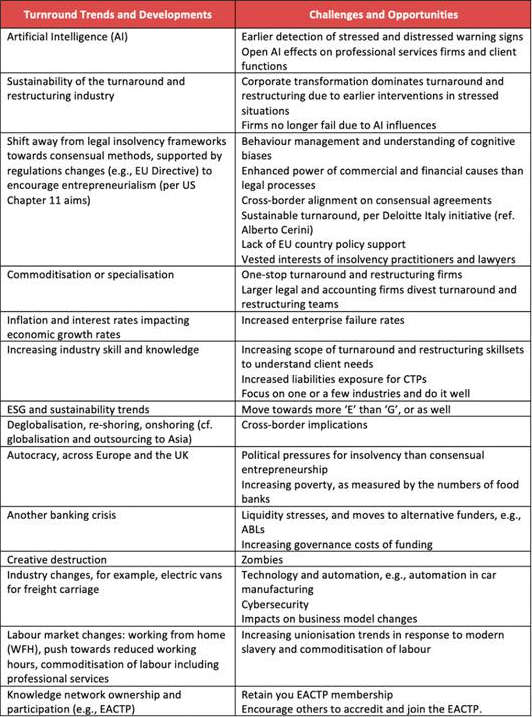The Future of Turnaround
By Simon C. Jones CTP FCPA
The Future of Turnaround. What will it look like?
2023 Turbocharged Turnaround Conference, held on Thursday the 30th and Friday the 31st of March 2023, at Leiden University, The Netherlands.
Introduction
In March, the EACTP held its first educational event called ‘TURBOCHARGED TURNAROUND’, a series of high-level, immersive educational workshops at Leiden University in The Netherlands.
The aim of the conference was to share experiences, vision, and culture of the collective EACTP membership in attendance to help achieve sustainable and value saving client engagements.
Over two days, professors from the Universities of Cambridge, Westminster and Leiden led workshops and a live research project designed to challenge, engage, and leave delegates with new knowledge and the ability to prosper in challenging and unknown situations.
During TURBOCHARGED TURNAROUND, Prof. Jan Adriaanse led a workshop on the topic of ‘The Future of Turnaround’ and this article summarises his teachings on turnaround behaviours and the live research project outcomes over the two days.
Turnaround Behaviours
Prof. Jan Adriaanse’s academic and research focus is on turnaround behaviours, as well as the law and technical aspects of turnaround.
According to Jan, most companies wait for between 16 and 24 months from first seeing the warning signs needing action to counter adversity. This means they often find themselves in the liquidation phase before bringing in turnaround expertise to deal with even more complex and pressing distressed situations.
But why wait so long so act? It usually comes down to narcissism, pride, denial, fear, and depression, or what Jan summarises as ‘uncomfortable truths’. Overcoming these common behavioural aspects are key to recovering distress before it gets too deep and can be challenged proactively by external, independent, and influential turnaround expertise.
Part of the solution, Jan says, is to challenge cognitive biases (an educational topic EACTP will soon be focusing on for our members).
Cognitive biases create their own "subjective reality", not the objective input, which dictate behaviours, leading to perceptual distortions, inaccurate judgments, illogical interpretations, and irrationality. Examples include denial, blind spots, and seeking facts to support one’s beliefs.
Supporting Jan’s teaching, Alberto Cerini, CTP also presented a four pillars leadership model of corporate turnaround, asserting that the leadership needed in turnaround must be strong, a bit bossy and purposefully directive.
Trust, then, in the relationships formed during a turnaround is the biggest issue, grounded in the behaviours of all parties concerned.
The Future of Turnaround
Prof. Jan then led a session where he asked for engagement on the topic of the next 5 to 10 years in turnaround, grouped by Trends and Developments and likely Challenges and Opportunities.
Discussion, research, and development is ongoing but the outcomes from the two day’s live research project can be summarised in the below table:

Overall, many turnaround trends and new developments were identified, some of which present opportunities and some of which present challenges. While some of these trends may not stick, some will likely become part of the fabric of turnaround in 5 or 10 years. While we cannot know which will stick and which will fall away, it is our duty as turnaround professionals to stay current and anticipate what might be coming and mitigate threats or seize opportunities where possible.
Maintaining and updating our education and learning from peers both in our jurisdictions and others can only help.
Share this page:
